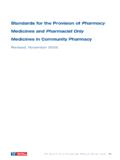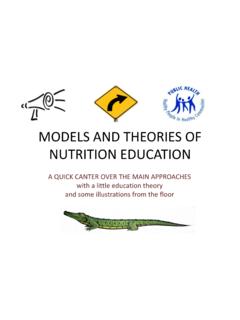Transcription of NATIONAL COMPETENCY 2016 STANDARDS FRAMEWORK …
1 2016 NATIONAL COMPETENCYSTANDARDS FRAMEWORK FOR PHARMACISTSIN AUSTRALIA Pharmaceutical Society of Australia Ltd., 2016 DisclaimerThe Pharmaceutical Society of Australia has made every effort to ensure that, at the date of publication, the document is free from errors and that advice and information drawn upon have been provided in good faith. Neither the Pharmaceutical Society of Australia nor any person or organisation associated with the preparation of this document accepts liability for any loss which a user of this document may suffer as a result of reliance on the document and in particular for: use of the document for a purpose for which it was not intended; any errors or omissions in the document; any inaccuracy in the information or data on which the document is based or which are contained in the document; or any interpretations or opinions stated in, or which may be inferred from, the following organisations were involved in the development of this publication and have endorsed the final FRAMEWORK : Australian Association of Consultant Pharmacy; Australian College of Pharmacy; Australian Pharmacy Council; Council of Pharmacy Schools: Australia and New Zealand Inc.
2 ; NATIONAL Australian Pharmacy Students Association; Pharmaceutical Defence Limited; Pharmaceutical Society of Australia; Pharmacy Board of Australia; Professional Pharmacists Australia; Society of Hospital Pharmacists of Australia; The Pharmacy Guild of comments about this publication may be sent at any time to the Pharmaceutical Society of Australia, the custodian of the document on behalf of the Australian pharmacy Policy UnitPharmaceutical Society of AustraliaPO Box 42 Deakin West ACT 2600 Email: ISBN: 978-0-908185-03-0 (Digital) NATIONAL COMPETENCY STANDARDS FRAMEWORK for Pharmacists in Australia 2016 | 1 Section 1 TABLE OF CONTENTSS ection 1 Glossary of terms ..2 Introduction ..7 Background ..8 Key influences ..8 The professional practice context ..8 Understanding the dimensions of practice ..8 Scope of practice ..9 Measuring performance ..10 Advanced level practice ..10 Refinement of the continuum of practice ..10 Requisite knowledge, skills and STANDARDS , quality STANDARDS and guidelines.
3 12 About the 2016 structure of the FRAMEWORK ..13 Applications of the 2016 FRAMEWORK ..16 Creating an individualised professional practice profile ..18 Section 2 2016 NATIONAL COMPETENCY STANDARDS FRAMEWORK ..19 Comparison of terminology ..20 Section 3 Appendix 1: The development of a NATIONAL COMPETENCY STANDARDS FRAMEWORK ..98 Summary of the history of the COMPETENCY STANDARDS ..98 Overview of the development process for the 2016 recommendations of Phase 1 ..101 Decisions of Phases 2 and 3 ..101 Summary of changes to the 2012 APPF STANDARDS ..103 Appendix 2: Comparison of the 2010 and 2016 Frameworks ..108 2 | NATIONAL COMPETENCY STANDARDS FRAMEWORK for Pharmacists in Australia 2016 Section 1 Glossary of termsThe following definitions have been adopted in this answerable for one s actions, and the roles and responsibilities inherent in one s job or position. Accountability cannot be qualitative measure of the extent to which a consumer s behaviour corresponds with the recommendations agreed with a health care professional, ideally through a concordant approach.
4 This can include accidental non-compliance ( forgetting, misunderstanding directions).1 Advanced pharmacy practicePractice that is so significantly different from that achieved at initial registration that it warrants recognition by professional peers and the public of the expertise of the practitioner and the education, training and experience from which that capability was drug reactionA drug response that is noxious and unintended, and which occurs at doses normally used or tested in humans for the prophylaxis, diagnosis or therapy of disease, or for the modification of physiological medicines eventAn adverse event due to a medicine. This includes the harm that results from the medicine itself (an adverse drug reaction) and the potential or actual patient harm that comes from errors or system failures associated with the preparation, prescribing, dispensing, distribution or administration of medicines (medication incident).3 AutonomyHaving a sense of one s own identity and an ability to act independently and to exert control over one s environment, including a sense of task mastery, internal locus of control, and responsible for, or taking part in, the provision of care for another person (including parents, guardians or care workers).
5 Carers may be formal or informal. A care worker is a paid worker with a title such as carer, aboriginal health worker, assistant in nursing, personal care assistant, HACC (Home and Community Care) person (other than a patient) or organisation receiving advice or service from a auditA quality improvement process that seeks to improve patient care and outcomes through a systematic review of the structure, processes or outcomes of care against explicit criteria, identification of required actions for improvement, and the implementation of those actions. Changes may be implemented at an individual, team, or service level and further monitoring is used to confirm improvement in health care governanceA FRAMEWORK through which organisations are accountable for continuously improving the quality of their services and safeguarding high STANDARDS of care by creating an environment in which excellence in clinical care will reviewReview of patient-specific clinical information and patient parameters to evaluate their response to medication therapies and to detect and manage potential or actual medicines-related the context of medication management, collaboration is a process whereby consumers and health care providers share their expertise and take responsibility for decision making.
6 Accomplishing collaboration requires that individuals understand and appreciate what it is that they, and others, contribute to the whole .1 CompetencePossession by an individual of the required knowledge, skills and attributes sufficient to successfully and consistently perform a specific task or function to the desired COMPETENCY STANDARDS FRAMEWORK for Pharmacists in Australia 2016 | 3 Section 1 TermDefinitionSourceConsentPermission granted voluntarily by a consumer or individual who has been adequately informed ( of options, risks, benefits) and has the capacity to understand, provide and communicate their two-way communication process between the pharmacist and the consumer in which the pharmacist ascertains the needs of the consumer and provides him or her with the information required to safely and effectively administer medicines and/or use therapeutic process used to assess and/or verify the qualifications, experience, professional standing and other relevant professional attributes of practitioners for the purpose of forming a view about their competence, performance and professional suitability to provide safe, high quality health care services within specific organisational environments or health care (drug)Medicines used primarily in the treatment of cancer.
7 They have deleterious effects upon cells and many have been found to be mutagenic, teratogenic and area of practiceThe pharmacist s area of responsibility and accountability in professional use evaluationAuthorised, structured, ongoing system for improving the quality of medicine use within a health service organisation. Medicine use is evaluated by using pre-determined STANDARDS , and efforts are initiated to correct patterns of use which are not consistent with these STANDARDS . It includes a mechanism for measuring the effectiveness of these corrective situationsWhere the context of the problem is changing and requires regular who encourages self-directed literacyRepresents the cognitive and social skills which determine the motivation and ability of individuals to gain access to, understand and use information in ways which promote and maintain good promotionThe process of enabling people to increase control over their health and to improve their health outcomes.
8 It represents a comprehensive social and political process which not only embraces actions directed at strengthening the skills and capabilities of individuals, but also action directed towards changing social, environmental and economic conditions so as to alleviate their impact on public and individual general registrationIn this document, this relates to the occasion when an individual is seeking or has obtained general registration as a pharmacist in Australia for the first collaborationRefers to the positive interaction of two or more health professionals, who bring their unique skills and knowledge, to assist patients/clients and families with their health individual who has completed a course of study in pharmacy and is undertaking a period of supervised practice and an approved training course in accordance with requirements set down by the Pharmacy Board of Australia as a prerequisite for applying for general registration as a pharmacist in Australia for the first time.
9 Interns are required to hold provisional registration with the Pharmacy Board of cultureA culture in which front-line operators and others are not punished for actions, omissions or decisions taken by them which are commensurate with their experience and training, but where gross negligence, wilful violations and destructive acts are not process of influencing the behaviour of others toward a pre-determined of selfA process where a person who knows their strengths and weaknesses, understands and displays self-awareness, self-regulation, motivation, empathy and social skill and commits to self-reflection and 4 | NATIONAL COMPETENCY STANDARDS FRAMEWORK for Pharmacists in Australia 2016 Section 1 TermDefinitionSourceManagement control systemThe formalised routines, reports and procedures that use information to maintain or alter patterns of organisational information systemA system that generally contains comprehensive data about all transactions within an medicine used by a specific patient according to a particular dosing errorA preventable event that may cause or lead to inappropriate medication use or patient harm while medication is in the control of the healthcare professional, patient or management planA continuing plan for the use of medicines that arises from a medication management assessment and is developed by the health care professional in collaboration with the chemical substance given with the intention of preventing, diagnosing, curing, controlling or alleviating disease or otherwise enhancing the physical or mental welfare of people.
10 Includes prescription and non-prescription medicines, including complementary health care products, irrespective of the administered experienced, skilled and trustworthy person who is willing and able to provide guidance to less experienced colleagues. Mentors share their knowledge, expertise and experience on career, technical, professional and cultural issues. The teaching -learning process is usually a one-to-one, reciprocal, career development relationship between two individuals who may be diverse in age, personality, life cycle, professional status and/or regular measurement or assessment of specific clinical and social parameters to assist consumers undergoing treatment for, or at risk of, specific health relationship where there is a sharing of expertise and responsibility among doctors, nurses, pharmacists and consumers for a person s wellbeing. Working in partnership involves consultation between individuals and collaborative decision person who uses or is a potential user of health services, including their family and carer(s).





